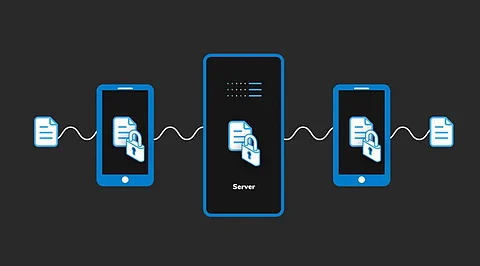

End-to-End Encryption (E2EE) is a cybersecurity technique that ensures data is encrypted on the sender’s device and remains encrypted until it is decrypted on the recipient’s device. It uses public key cryptography, making the content inaccessible to third parties, even service providers. This ensures that sensitive communications are protected from unauthorized access during transmission, maintaining user privacy and security.
End-to-end encryption works by utilizing a pair of cryptographic keys:
Public Key (for encryption): Shared with others to encode messages.
Private Key (for decryption): Kept secret and used to decode messages.
The message is encrypted on the sender's device and can only be decrypted by the intended recipient’s private key. This ensures that no intermediary, including servers or internet service providers, can access the content during transmission.
Ensures Complete Privacy : Only the sender and recipient can access the message content, blocking unauthorized access from hackers, governments, or service providers.
Builds User Trust: E2EE eliminates the need to trust intermediaries, assuring users that their communications remain private and secure.
Protects Sensitive Communications: Whether it’s personal messages, financial data, or health information, E2EE prevents data leakage over insecure networks.
Maintains Integrity Over Insecure Channels: Even when data is transmitted across vulnerable or public channels, E2EE ensures that the content remains confidential.
Critical for Activists and Journalists: In high-risk regions, E2EE is essential for protecting identity and sensitive exchanges from surveillance or retaliation.
Strong Confidentiality: Ensures data remains unreadable to unauthorized users during transmission.
Reduces Risk of Data Breaches: Prevents hackers from intercepting readable data, lowering cyberattack success.
Regulatory Compliance: Helps organizations meet data protection standards like GDPR, HIPAA, etc.
Cloud Security: Keeps files encrypted even in storage, safeguarding them from internal or external threats.
Insider Threat Protection: Prevents internal misuse by restricting access to decrypted data.
Key Management Challenges: Loss of encryption keys leads to permanent data loss, requiring strict protocols.
Limited Data Usability: Encrypted data cannot be easily searched or analyzed, affecting business intelligence.
Compatibility Issues: Different encryption methods across systems can create integration complexities.
No Recovery Options: Forgotten or lost keys result in irretrievable data without fallback mechanisms.
Criminal Exploitation: Encrypted communication can conceal illegal activities, complicating law enforcement efforts.
These platforms use E2EE to ensure only senders and recipients can read messages, protecting private conversations.
E2EE-enabled email providers ensure email content is protected from interception during transfer and in storage.
Files remain encrypted both in transit and at rest, preventing unauthorized access to user documents and media.
Patient consultations and records are encrypted to meet healthcare privacy regulations and protect sensitive health data.
E2EE secures transactions and communications between customers and banks to prevent fraud or theft.
Meetings, chats, and shared documents are encrypted to protect business-critical discussions and files.
Sensitive operations and strategic discussions are protected from espionage through robust E2EE implementations.
End-to-End Encryption secures data so only the sender and intended recipient can read it. No intermediaries, including service providers, can access the encrypted content.
It guarantees complete data confidentiality by preventing third parties, hackers, or surveillance from reading communications, even over insecure networks.
No. Since data is encrypted on the sender’s device and decrypted only on the recipient’s device, providers cannot read or access the message.
Losing your private encryption key makes the data permanently inaccessible, as there’s typically no recovery method without that specific key.
While E2EE protects communication content, it doesn’t prevent other cyberattacks like phishing or malware. It must be combined with broader security practices.
